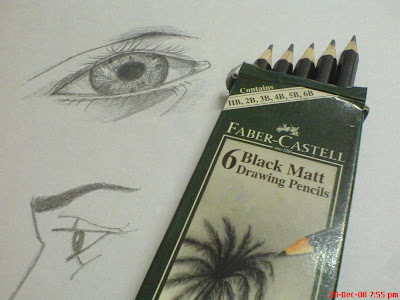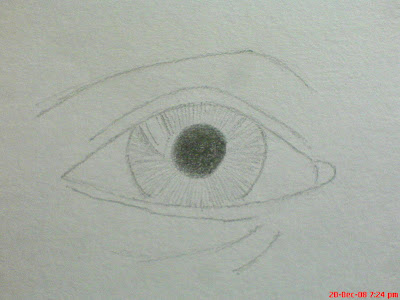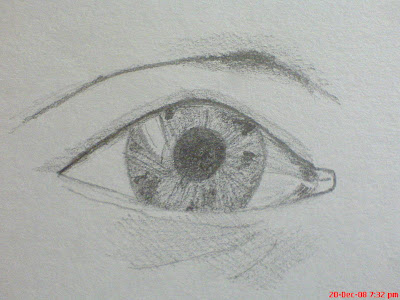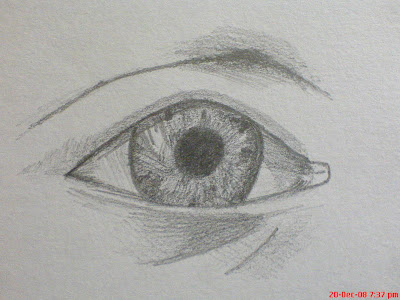As I promised, this time I am going to give a "detailed" explanation of 'How to draw an Eye?' - my second post. Eyes are the most important part to focus on while drawing portraits. They denote the feelings of a person. Observation plays major role in drawing. For example, people like to see pleasing faces, so while drawing such eyes, observe that pupil of the eye dilate when someone is pleased. So draw a wider pupil to get that feel.
Coming to the point, I am doing a pencil sketch this time, working on the rough side of the sheet. I am using Faber-Castell pencils. These are so fine for pencil sketching/shading.

Sometimes I draw the eyelid edges, then the iris, sometimes the iris then the eyelids - it works either way. I usually draw the iris as a full circle then erase where it overlaps the eyelids, so that the shape is correct. Then I draw the outer eyelid edges and any folds or creases around the eye.
First check for any highlights cutting across the eye surface, and lightly outline these (HB). Shade the iris using directional shading to mimic its radiant patterns. Shade the pupil too (4B), establishing good, solid darks. Watch out for highlights across the pupil too - if they are there, put them in. As I told, I am making the pupil wider to bring a friendly look. Also make a highlight curve across it, to emphasize the shiny curved surface of the eyeball.

Now I'm adding some shading to the drawing. I add a fine layer across all of the inner white of the eye, and very, very lightly across the outer one (2B). The 'whites' aren't really white, but slightly shaded with 2B. Reserve pure white for your highlights as much as possible. Use eraser whereever you feel necessary. And now, I add a layer of shading to the upper eyelid, an some shadows around the eye. At this stage, the shading is quite strong (3B/4B) - I'll soften it with an eraser (You can cut the eraser with a blade angularly to erase small portions). You can't see all the details in the pictures ;-) pics are taken in the night under tube light.
The eye drawing is almost finished. The shading in the eye is completed, making sure the white highlights are crisp. Notice the shadow drawn under the upper eyelid. This helps to give it a more three-dimensional look (I couldn't make this well). Skin tones require a fine touch with shading. I used an eraser to lift excess tone, sometimes re-drawing several times until I get the subtle shading that I want. I have made the shading in the whites of the eye a little darker so that the highlights look brighter.
Notice that I haven't drawn the eyelashes yet. I want to be able to smudge and erase the tones on the eyelids without disturbing the eyelashes. To finish off the eye drawing, I've softened some of the shading further to create quite a smooth effect, and crisped up the highlights in the eye. Then I have added the eyelashes. Look carefully at the eyelashes - note where they start. A few hairs straying inwards, but most eyelash hairs grow quite precisely out of the front edge of the eyelid. Use an almost flicking motion, lifting the pencil towards the end of the hair, to draw the natural taper of the eyelash.
Drawing side view:
I always had a problem in drawing the side view of an eye until I observed great geometry in it. Have a look at this pic:
Start studying the structures, everything in this universe is a marvel. Look at the geometry of side angle of the eye. Simple... right? :-) we need to erase certain portions of this basic drawing later. Now, highlight necessary arcs. I did a little bit of smudging to the eyebrow. Isn't this easy?
(Please bear with the bad picture clarity. They are taken with Sony Ericsson K750i - 2MP camera).






 How to start?
How to start?
